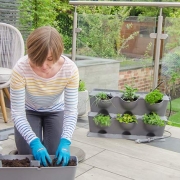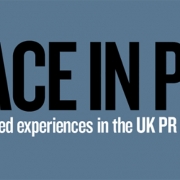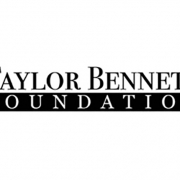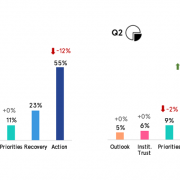Gardening Blogger Spotlight: Catherine Hughes, Growing Family
From grubbing around on allotments as a child to blogging full-time about gardening now she has children of her own, Growing Family’s Catherine Hughes has turned her passion for plants into a career she loves.
With gardening becoming more and more popular as people are getting the most out of going outdoors, Catherine shares which kind of posts are proving most useful for her readers, gardens that inspire her, and whether gnomes should be standing next to your Salvia.
How did you originally get started with writing about gardening?
I’ve always been fascinated by the process of making things grow; I grew up grubbing around on my dad’s allotment, and I’ve been gardening for as long as I can remember. Before having children I worked in brand marketing, but gave up the full-on career to be a full-time mum. This gave me a chance to start a whole new career blogging about my passion. Now I get to combine gardening with my day job, which is pretty amazing!
What’s your favourite thing to post about and why?
Easy gardening projects that you don’t need to be an expert to try and that you can involve the kids in. I firmly believe you don’t have to be a pro to enjoy gardening and I hope my blog inspires people to have a go and have fun in the process.
How have you had to change your approach to blogging during the COVID-19 crisis?
With gardening seeing such a big increase in popularity, I’ve been focusing my writing on topics that appeal to newly-interested gardeners and those who are trying to garden with limited resources. Brand work has been reduced, so I’m working more on SEO and my social channels. I’m also blogging at some odd times of day to fit in around the kids!
What are some small things people can do to change up their gardens/balcony planters/windowsill flowers while on lockdown?
Adding in some summer bedding plants will give things an instant lift, and they’re easy to get hold of from supermarkets and garden centres. You can also make things more interesting in the garden by providing food for wild birds and encouraging them to visit. Having a go at growing your own veg is a great lockdown project, too – I’ve converted one of my garden borders into a vegetable patch this year.
For those just getting into gardening, which essential tools do they need for their kit?
A decent hand trowel, comfortable gardening gloves, and a kneeler pad will all get used every time you garden. Plant pots in various sizes and plant labels are a must if you’re growing seeds; avoid plastic and go for an eco-friendly option if you can. A lightweight handled bucket is brilliant for moving around compost and collecting weeds, but you can improvise on this one if you need to. I’d also add in a spade if you’ve got more than just containers. And you definitely need a watering can to keep those plants happy!
Most beautiful outside space/garden you’ve ever seen?
I have a real soft spot for the Japanese gardens at Newstead Abbey. They’re so precise but luscious at the same time, and there’s something about the contrast between the historic surroundings and the vibe that just works for me. I find something new and inspiring every time I visit.
What are your thoughts on garden gnomes – cute, or creepy?
Definitely creepy – they’ve always given me the shivers. I don’t want eyes watching me in the garden!
How do you collaborate with brands and which kind of brands do you really like working with?
I really enjoy collaborating with brands and regularly work on ambassadorships, sponsored content, reviews, giveaways, guest writing and social media promotion. Home and garden brands are the best fit for my content and audience.
For PRs looking to work with you and your blog/website, how would you prefer they approach you and with what kind of content?
My readers expect and enjoy unique content, so that’s always my aim when working with PRs. I’m always interested in press releases related to my blog’s content as they keep me up-to-date, but I don’t tend to publish them on my blog. A detailed brief is really important; as well as being a professional way to work, it helps avoid misunderstandings and saves lots of time. The best way to contact me is via email.
What other blogs do you check out regularly (whether gardening-related or not)?
There are lots of gardening blogs on my list! The Middle-Sized Garden always has articles that inspire me, Sharpen Your Spades is brilliant for all things grow your own, and Gardens, Weeds & Words is beautifully written with stunning photography. I also love Thrifty Home for great family budgeting tips, and Love Chic Living for fantastic interiors inspiration.






























